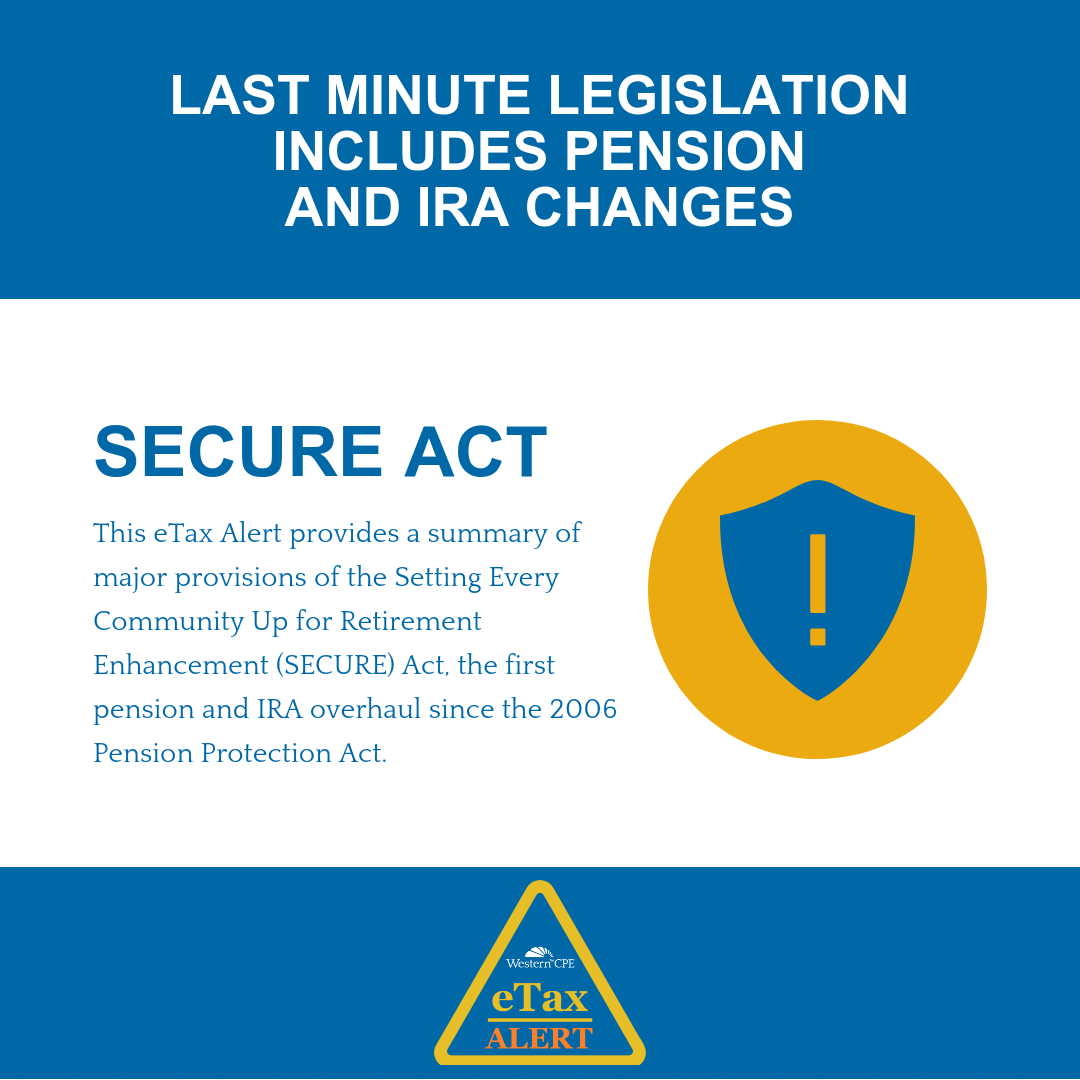
The SECURE Act – Last Minute Legislation Includes Pension and IRA Changes
The Further Consolidated Appropriations Act, 2020, (HR 1865) was must-pass legislation or the government would have closed down on Dec. 21, 2019. Tacked onto the critical appropriation bill were many year-end tax changes — some retroactive. Included in the new law are pension and IRA reform provisions, extenders, disaster relief, and the repeal of a few ACA taxes.
Below is a summary of major provisions of the Setting Every Community up for Retirement Enhancement (the SECURE ACT)1, the first pension and IRA overhaul since the 2006 Pension Protection Act.

SECURE ACT
The bipartisan Setting Every Community up for Retirement Enhancement (SECURE) Act was passed by the House in May 2019 with a 417-3 vote. It was held up by Sen. McConnell for most of the year until the appropriation bill seemed a likely last minute place to attach the pension reform package.
IRA CHANGES
RMDs. SECURE changes the start date for required minimum distributions (RMDs) to age 72. The age change applies to distributions required to be made after Dec. 31, 2019, with respect to individuals who attain age 70½ after such date.
For those who turned 70½ in 2019, their first RMD must be taken by Apr. 1, 2020. Anyone who turns 70½ in 2020 will not have to take their RMD until they turn 72.
Note. Pushing the RMD age out to age 72 does not change the qualified charitable distribution (QCD) rule. Thus, a taxpayer who is 70½ may make a QCD and reduce his or her RMD. But see “coordination with QCD” below.
IRA contributions after age 70½. Beginning in 2020, the age limit for contributions to an IRA has been eliminated. In prior years, contributions to an IRA were not allowed beginning for the year the taxpayer turned 70½.
Coordination with QCD. Because IRA contributions are now deductible for those who qualify for the qualified charitable distribution (QCD) provision, SECURE reduces the allowable QCD by the IRA deduction allowed for a taxpayer over 70½. ‘‘The amount of distributions not includible in gross income by reason of the preceding sentence for a taxable year shall be reduced (but not below zero) by an amount equal to the excess of— ‘‘(i) the aggregate amount of deductions allowed to the taxpayer under §219 for all taxable years ending on or after the date the taxpayer attains age 70½,‘‘(ii) the aggregate amount of reductions under this sentence for all taxable years preceding the current taxable year.’’
Example. Joe made traditional IRA contributions at age 71 and 72 for a total of $14,000. A few years later, Joe directs the custodian of his IRA to make a qualified charitable distribution of $25,000 to the Salvation Army. The first $14,000 of the distribution is not treated as a QCD. Thus, $14,000 will be included in Joe’s income as a taxable distribution and Joe may deduct $14,000 on his Schedule A as a charitable contribution.
Non-spouse beneficiary. The “stretch” distribution period for non-spouse inherited IRAs is reduced to a 10-year maximum, from a lifetime distribution. Within the 10-year period, there are no required distributions. But, the entire inherited retirement account must be distributed by the end of the 10-year period. In a change from prior law, the 10-year period applies regardless of whether the plan participant or IRA owner dies before or after reaching their required beginning date for distributions.
Example. Joe’s father dies in 2020 and names Joe as the beneficiary of his $500,000 IRA. Joe may withdraw funds from the IRA as he wishes, but the entire account balance must be withdrawn by the end of the 10-year period.
The 10-year distribution limit does not apply to “eligible designated beneficiaries”. These include:
- a surviving spouse2;
- a minor child3 (the exception for a minor child no longer applies once the child reaches the age of majority and the remainder of the distributions to that individual must be completed within 10 years after that date);
- a disabled individual (§72(m)(7));
- a chronically ill individual (§7702B(c)(2)); and
- an individual who is not more than 10 years younger than the deceased participant or IRA owner.
The change applies to distributions to a non-spouse beneficiary from retirement plans and IRAs made if the plan participant or IRA owner’s death occurs after Dec. 31, 2019.
Tax practitioner planning. For those who have named a trust as the beneficiary of their IRA or pension accounts, a review of the trust document is essential. Some “look-through trusts” have distribution provisions that may result in distributions be held up until the tenth year.
Birth and adoption distributions. Distributions for the birth or adoption of a child of up to $5,000 per individual are penalty-free withdrawals from an IRA and a qualified pension plan. To meet the requirements of the qualified birth or adoption distribution, the individual must take a distribution during the one-year period beginning on either the date of birth of the child, or the date of the final adoption of the child (under age 18). An individual taking a distribution for the birth or adoption of a child may make an additional contribution back to the plan from which the distribution was made or to an IRA. The IRS will need to provide timing rules for the repayment.
Tax practitioner planning. Spouses may each take a $5,000 distribution if each has a retirement account.
A distribution is not treated as a qualified birth or adoption distribution with respect to any child or eligible adoptee unless the taxpayer includes the name, age, and TIN of such child or eligible adoptee on the taxpayer’s tax return for the taxable year. This change is effective for distributions made after Dec. 31, 2019.
Two amounts treated as compensation for IRAs. Certain taxable non-tuition fellowship and stipend payments to graduate and post-doctoral students are treated as compensation for IRA purposes. This change is effective for taxable years beginning after Dec. 31, 2019.
Excluded difficulty of care payments (§131) are treated as compensation for determining non deductible IRA contributions. This change is effective for contributions made after Dec. 20, 2019.
401(k) Changes
Part-time employees. 401(k) plans are required to offer participation to long-term, part-time employees. Employers with 401(k) plans must offer employees who work between 500 and 1,000-hours a year an additional means to participate in the plan. The rule change only affects 401(k) cash or deferral arrangements, and no other qualified plans. A part-time employee is eligible to participate in the employer’s 401(k) plan if the employee has at least 500 hours of service in three consecutive 12-month periods.
The change applies to plan years beginning after Dec. 31, 2020, except that the12-month periods beginning before Jan. 1, 2021 are not taken into account. Thus, the earliest that a part-time employee will be able to participate in the 401(k) plan is 2024.
Automatic enrollment credit. To encourage participation, a new tax credit of $500 for a three-year credit period is allowed for small employers adding an auto-enrollment provision to their plans. The new credit applies for taxable years beginning after Dec. 31, 2019.
Automatic enrollment percentage increased. Beginning in 2020, the SECURE Act allows the plan to set the automatic enrollment percentage to as high as 15% (was 10%).
Annuity offerings in 401(k) plans. SECURE updates the safe harbor provision for plan sponsors to offer annuities in their 401(k) plans to ease liability concerns. New ERISA §404(e) provides a Fiduciary Safe Harbor for fiduciaries selecting a “lifetime income provider.” When selecting an annuity provider, the fiduciary must engage in “an objective, thorough and analytical search” of providers and obtain several written representations from the annuity provider selected.
SECURE also provides that pension plans may make a direct trustee-to-trustee transfer to another employer plan or IRA of lifetime income investments in the form of a qualified plan distribution annuity, if a lifetime income investment is no longer allowed as an investment option in a plan.
RETIREMENT PLANS FOR SMALL EMPLOYERS
Several changes are made to encourage more small employers4 to offer retirement benefits to their employees, such as:
Pension plan start-up-cost credit. The credit for a small employer starting a pension plan, such as a 401(k), 403(b), SEP IRA or SIMPLE IRA, has been increased for taxable years beginning after Dec. 31, 2019. For the first credit year and each of the two taxable years immediately following the first credit year, the credit is the greater of—
(A) $500, or
(B) the lesser of—
(i) $250 for each employee of the eligible employer who is not a highly compensated employee and who is eligible to participate in the eligible employer plan maintained by the eligible employer, or (ii) $5,000.
Example. Sharon starts a SEP IRA in 2020 for her and one employee. She is entitled to a start-up credit of $500 (2 times $250) for 2020, 2021 and 2022.
Example. Vern starts a 401(k) plan for him and his 20 employees. Vern is entitled to a start-up credit of $5,000 (21 times $250 limited to $5,000) for 2020, 2021 and 2022.
Multiple employer plans. Small employers of two or more employees may come together to participate in a new class of pooled multiple employer plans (MEPs). A MEP essentially allows small employers to join together to offer pension plans with (presumably) lower administrative costs. A critical factor that made employers skeptical of the MEP was the IRS’s “bad apple” rule. The IRS said that if one employer in the plan defaulted, the whole plan was disqualified. The SECURE Act now provides that if a single employer defaults, the remaining plan maintains its qualified status. SECURE requires the MEP to be administered by a “pooled plan provider.” Generally, changes apply to plan years beginning after December 31, 2020.
MISCELLANEOUS CHANGES
Establishing a retirement plan. Beginning in 2020, employers may adopt retirement plans that are entirely employer funded up to the due date of the tax return, including extensions. Current law requires the employer to establish their plan by December 31 (or the last day of their fiscal year.)
Kiddie tax. For tax years beginning after Dec. 31, 2019, the unearned income of certain children is again taxed at the parents’ tax rate. In 2018 and 2019, the Tax Cuts and Jobs Act taxed the unearned income of children using the much higher trust tax rates. BUT, SECURE allows a taxpayer to elect (at such time and in such manner as the IRS may provide) for the change to apply to taxable years beginning in 2018, 2019, or both (as specified by the taxpayer in his or her election).
529 PLAN
- Student loans. SECURE provides that up to $10,000 (reduced by the amount of distributions so treated for all prior taxable years) may be withdrawn from a 529 plan for the purpose of paying principal or interest on any qualified education loan of the beneficiary or his or her siblings. Effective for distributions made after Dec. 31, 2018.Note. The loan interest paid off with the distribution is not deductible.
- Apprenticeship programs. SECURE also provides that a qualified distribution includes tuition, books, supplies and equipment required for Apprenticeship Programs if the program is properly registered and certified by the Department of Labor. Effective for distributions made after Dec. 31, 2018.
PENSION PROVISIONS IN DISASTER TAX RELIEF
New rules apply to individuals who had a principal residence in a federally declared disaster area and who suffered an economic loss as a result of the disaster. The disaster must have occurred from Jan. 1, 2018 through Feb. 18, 2020 (60 days after the enactment of the law).
- Qualified disaster distributions. The Appropriations Act also includes provisions relating to qualified disaster5 distributions from retirement accounts. A qualified disaster distribution is one made beginning on the first day of the incident period of the qualified disaster and ending on the date which is 180 days after Dec. 20, 2019 (the date of the enactment).Qualified disaster distributions can be made up to $100,000 and
- Are exempt from the 10% early withdrawal penalty,
- Are exempt from mandatory withholding requirements,
- Are treated as evenly distributed over a three-year period, and
- May be repaid within three years of the distribution.
- Pension Plan Loans for Qualified Disasters. The limit on loans from retirement plans for a qualified disaster increased to $100,000 (was $50,000). Disaster loan repayments are delayed for up to one year.


